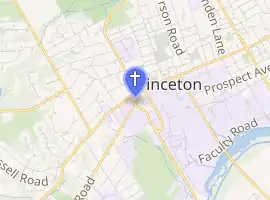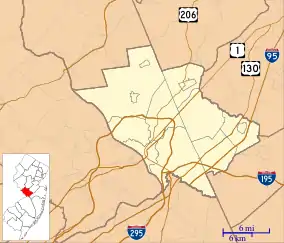Trinity Church, Princeton
Trinity Church is a historic Episcopal congregation located at 33 Mercer Street in Princeton, New Jersey. It is the largest Episcopal church in New Jersey.[2]
| Trinity Church | |
|---|---|
.jpg.webp) | |

| |
| Location | Princeton, New Jersey |
| Country | United States |
| Denomination | Episcopal |
| Churchmanship | High church |
| Membership | 2,000 |
| Weekly attendance | 400 |
| Website | trinityprinceton |
| History | |
| Founded | 1833 |
| Architecture | |
| Architect(s) | Charles Steadman (1833), Richard Upjohn (1870), Ralph Adams Cram (expansion 1914) |
| Style | Greek Revival (1833–1870), Gothic architecture (1870–present) |
| Completed | 1870 |
| Administration | |
| Diocese | Diocese of New Jersey |
| Province | Province II |
| Clergy | |
| Bishop(s) | William H. Stokes |
| Rector | Paul Jeanes III |
| Curate(s) | Christopher McNabb |
| Laity | |
| Organist/Director of music | Tom Whittemore |
Trinity Episcopal Church | |
   | |
| Coordinates | 40°20′49.9″N 74°39′52.6″W |
| Part of | Princeton Historic District (ID75001143[1]) |
| Added to NRHP | 27 June 1975 |
History
Trinity was a relative latecomer in mainly Calvinistic central New Jersey. Princeton Borough, in particular, was a heavily Presbyterian village, anchored by the College of New Jersey (now Princeton University) and Princeton Theological Seminary. A handful of local would-be parishioners, including a number with southern connections, founded Trinity in 1833, building a modest Greek Revival meeting hall as their church. Miller Chapel, a stone's throw away on the Princeton Theological Seminary campus, is a similar building by the same local architect-builder, Charles Steadman, who also designed many houses in the neighborhood.[3]
Nineteenth Century
.jpg.webp)
In 1870 the original structure gave way to a larger, more assertively Episcopalian building designed in the Gothic Revival style by Richard Upjohn and his son. This remained until the first decade of the last century, when architect Ralph Adams Cram doubled the nave in length. In 1914, Cram was hired again to create a small chapel in the north transept (the Lady Chapel), a larger French Gothic chancel, and a significantly heightened tower accommodating a small carillon of ten Meneely bells.[4] With some interior alterations, this is today's church building. A stone over the chancel door is from the 13th century St. Oswald's Church near Malpas, the original Stockton family home.[5]
In 1850 the church built a gothic schoolhouse (now attached to the parish house and serving as offices) to serve as a Sunday School for parish children (itself an innovation), and at other times as a school for African-American children, whom the local schools did not serve. In the second half of the 19th century, Trinity founded several nearby missions, of which two survive independently.[6]
Starting in 1879, Trinity, like many Episcopal parishes, participated in the Choral Revival in the Anglican church, with its emphasis on vested choirs of men and boys trained by professional church musicians, and singing quality church music. Thus began its choir program, long one of the finest in the nation. This rigorous program, now coeducational, has thrived under a succession of gifted leaders, including notable Anglican musicians John Bertalot and Tom Whittemore.
Twentieth Century
.jpg.webp)
_01.jpg.webp)
Through the 1920s, '30s, and early '40s, Trinity slowly grew with its town. The growth of Princeton Township (surrounding the Borough) and today's extensive suburbs were yet to come. During the baby boom of the late 1940s and the '50s, Trinity experienced explosive growth in young families with children, with a burgeoning Sunday School (at one point claiming five hundred members) that old-timers remember fondly. Through that period the parish ministry remained essentially traditional, with outreach a minor component and the Rector and assisting clergy very much in charge. During the '50s, a large parish hall (Pierce Hall), kitchen and meeting room were built to accommodate the growing demands for space.
The 1960s witnessed a devastating fire (1963) and reconstruction in the church proper, as well as the beginning of two enduring outreach efforts: Trinity Counseling Service and All Saints' Church, which was created in 1960 as a neighborhood church to serve the fast-growing eastern end of Princeton Township with its own vicar. An attractive stone church with parish house was built at the outset, and under fine clergy and lay leadership it quickly became independent. The two parishes share Trinity-All Saints' Cemetery, next to All Saints', and some other undeveloped property at the site of All Saints'. All Saints' was the brainchild of The Rev. Dr. John Vernon Butler, Rector from 1948-59. Dr. Butler, a strong leader, followed The Rev. Arthur Lee Kinsolving (1940–47), who had moved to New York City to lead St. James's, Madison Avenue. Butler served 11 years, then became dean of New York's Cathedral of St. John the Divine, and later Rector of Trinity Church, New York. Under his leadership, Trinity grew to more or less its present size.
Next, The Rev. Robert Spears saw Trinity through the fire and rebuilding of the mid-60s, and after seven years' tenure became Bishop of Rochester, New York. The Rev. James Whittemore served from 1967–77, during which Trinity evolved into something like its modern form, with expanded lay leadership, liturgical renewal, a revised church, enlarged facilities, and a more diverse and welcoming congregation. A long-awaited moment came when parishioner and clergy staff member The Rev. Daphne Hawkes—who remains a volunteer associate clergy—was ordained to the priesthood at Trinity, the first woman priest in the Diocese of New Jersey. Whittemore left to head the Seamen's Church Institute in New York City, now led by former Interim Rector The Rev. Jean Smith.
The Rev. John Crocker, Jr., came to Trinity in 1977 from the Episcopal chaplaincy at MIT and served until his retirement in 1989. His tenure included expanded outreach, consolidation of the many liturgical changes of the preceding years, and planning for needed facility improvements. In 1991, after an extended interim period, The Ven. Leslie Smith, Archdeacon of the neighboring Diocese of Newark, became Trinity's next rector, serving until his retirement in mid-2006. The current rector is the Reverend Paul Jeanes.
References
- "Princeton Historic District". National Register of Historic Places. National Park Service.
- "Participation & Giving Trends, Trinity Episcopal Church, Princeton, NJ" (PDF). The Episcopal Church. Retrieved 13 May 2014.
- "Trinity Church to Mark Anniversary on Sunday". The Town Topics. 7 May 2008. Retrieved 13 May 2014.
- "Dedication at Trinity Church This Morning". The Daily Princetonian. 12 May 1915. Retrieved 13 May 2014.
- Collins, Varnum Lansing (1919). Guide to Princeton: The Town, the University. Princeton: Princeton University Press. p. 18.
- "Trinity Church History". Retrieved 13 May 2014.